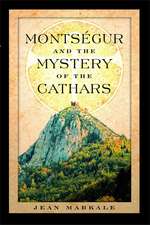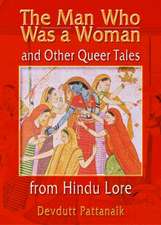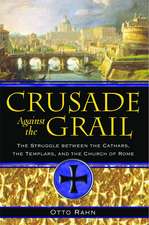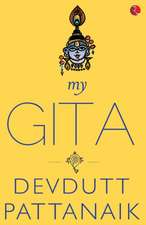Indian Mythology: Tales, Symbols, and Rituals from the Heart of the Subcontinent
Autor Devdutt Pattanaiken Limba Engleză Paperback – 23 apr 2003
Preț: 115.07 lei
Nou
Puncte Express: 173
Preț estimativ în valută:
22.02€ • 23.91$ • 18.50£
22.02€ • 23.91$ • 18.50£
Carte disponibilă
Livrare economică 02-16 aprilie
Livrare express 18-22 martie pentru 23.09 lei
Preluare comenzi: 021 569.72.76
Specificații
ISBN-13: 9780892818709
ISBN-10: 0892818700
Pagini: 256
Ilustrații: 50 b&w illustrations
Dimensiuni: 152 x 229 x 20 mm
Greutate: 0.32 kg
Ediția:Original
Editura: Inner Traditions/Bear & Company
Colecția Inner Traditions
ISBN-10: 0892818700
Pagini: 256
Ilustrații: 50 b&w illustrations
Dimensiuni: 152 x 229 x 20 mm
Greutate: 0.32 kg
Ediția:Original
Editura: Inner Traditions/Bear & Company
Colecția Inner Traditions
Notă biografică
A medical doctor by training, Devdutt Pattanaik moved away from clinical practice to nurture his passion for mythology. His books include The Goddess in India and introductions to Shiva, Vishnu, and Devi. He lives in Mumbai, India, where he works as a health communicator and writes and lectures on Hindu narratives, art, rituals, and philosophy.
Extras
from Chapter 1
The most important symbolism in Hinduism is that of man and woman. In most narratives, man represents spiritual reality; woman represents material reality. He stands for otherworldly pursuits; she stands for this-worldly passions. Worldliness is impossible without the presence of women; monasticism demands the absence of women. Man is the soul. Woman is the flesh. He is the cause. She is the manifestation. He is the self, pure awareness, and the true identity of our being. She is the energy, the matrix, in which the self is enmeshed. Since, he is the self, he is the ‘subject who experiences life’ and she is the ‘object who is experienced in life.’ She owes her existence to him. He owes his identity to her. He creates, sustains and destroys her. She enables him to preserve, propagate, indulge and realize himself. Just as man and woman are complimentary, so are spiritual and material realities. Hence, when God is to represented, Hindus choose not male or female, but both male and female. In Hindu temples therefore, God is always associated with the Goddess. In Vishnu temples one finds Lakshmi. In Krishna temples one finds Radha. In Rama temples one finds Sita. In Shiva temples one finds Shakti. Without either there is neither.
According to a Tamil temple lore, the sage Bhringi wanted to circumambulate Shiva. Shakti stopped him saying, “You must go around both of us because each of us is incomplete without the other.” Bhringi was adamant. To foil his plans, Shakti sat on Shiva’s lap. Bhringi took the form of a bee and tried to fly between them. So Shakti fused her body with Shiva’s and became his left half. Shiva now came to be known as Ardha-nari (the half-woman god). Bhringi then took the form of a worm and tried to bore a hole between them. Exasperated by his stubbornness, Gauri said, “If you only want him then may you be deprived of every tissue that a human gets from a woman.” Instantly, Bhringi was transformed into a skeleton. His body possessed neither flesh, nor bones, nor genitals. He could not even stand. Feeling sorry for him, Shiva game him a third leg so that he could stand up like a tripod. Bhringi apologized to Shakti having realized the complementary relationship between the God and Goddess.
The symbolism of man and woman is undoubtedly enmeshed in gender politics with man being the ‘cause’ and ‘consciousness’ while woman being ‘matter’ and ‘manifestation’. That man represents stillness and unchanging nature of the soul and woman represents flux and ever-changing nature of the material matrix says a lot about Hindu attitude towards manliness and womanliness. But such bias is innate in language. To truly appreciate the ‘idea’ behind the ‘symbol’ one has to transcend biology. Only then will the between God and Goddess transform into the conflict between individual and environment. Only then will the macrocosmic world of the divine coalesce with the microcosmic world of the self.
Table 4: Different meanings of man and woman in Hindu symbolism
Man
Spiritual reality
Pure consciousness
That which is not contained in space or subject to time
Soul
Subject
Individual
Seer
Culture
Woman
Material reality
Energy matrix
That which is contained in space or subject to time
Body and mind
Object
Environment
Scenery
Nature
Women and fertility symbols play an important role in household rituals such as marriage, childbirth, and harvest. On doorways symbols such fish, conch-shells, dots, are painted with red color. Pots filled with water topped with a coconut are placed on a pile of rice. Tender mango leaves and marigold flowers are strung together and hung at the doorway. On the floor just outside the doorway beautiful diagrams are drawn using white and colored powder. Sweet food is cooked in the house. Banana is offered to guests. Married women are invited to the household. They are given flowers, perfumes, gifts and red powder to apply on their foreheads. Without a wife, a man is not a householder. Without a husband, a woman is not a housewife. Only husband and wife as pillars of a household are allowed to perform fertility rituals.
The most important symbolism in Hinduism is that of man and woman. In most narratives, man represents spiritual reality; woman represents material reality. He stands for otherworldly pursuits; she stands for this-worldly passions. Worldliness is impossible without the presence of women; monasticism demands the absence of women. Man is the soul. Woman is the flesh. He is the cause. She is the manifestation. He is the self, pure awareness, and the true identity of our being. She is the energy, the matrix, in which the self is enmeshed. Since, he is the self, he is the ‘subject who experiences life’ and she is the ‘object who is experienced in life.’ She owes her existence to him. He owes his identity to her. He creates, sustains and destroys her. She enables him to preserve, propagate, indulge and realize himself. Just as man and woman are complimentary, so are spiritual and material realities. Hence, when God is to represented, Hindus choose not male or female, but both male and female. In Hindu temples therefore, God is always associated with the Goddess. In Vishnu temples one finds Lakshmi. In Krishna temples one finds Radha. In Rama temples one finds Sita. In Shiva temples one finds Shakti. Without either there is neither.
According to a Tamil temple lore, the sage Bhringi wanted to circumambulate Shiva. Shakti stopped him saying, “You must go around both of us because each of us is incomplete without the other.” Bhringi was adamant. To foil his plans, Shakti sat on Shiva’s lap. Bhringi took the form of a bee and tried to fly between them. So Shakti fused her body with Shiva’s and became his left half. Shiva now came to be known as Ardha-nari (the half-woman god). Bhringi then took the form of a worm and tried to bore a hole between them. Exasperated by his stubbornness, Gauri said, “If you only want him then may you be deprived of every tissue that a human gets from a woman.” Instantly, Bhringi was transformed into a skeleton. His body possessed neither flesh, nor bones, nor genitals. He could not even stand. Feeling sorry for him, Shiva game him a third leg so that he could stand up like a tripod. Bhringi apologized to Shakti having realized the complementary relationship between the God and Goddess.
The symbolism of man and woman is undoubtedly enmeshed in gender politics with man being the ‘cause’ and ‘consciousness’ while woman being ‘matter’ and ‘manifestation’. That man represents stillness and unchanging nature of the soul and woman represents flux and ever-changing nature of the material matrix says a lot about Hindu attitude towards manliness and womanliness. But such bias is innate in language. To truly appreciate the ‘idea’ behind the ‘symbol’ one has to transcend biology. Only then will the between God and Goddess transform into the conflict between individual and environment. Only then will the macrocosmic world of the divine coalesce with the microcosmic world of the self.
Table 4: Different meanings of man and woman in Hindu symbolism
Man
Spiritual reality
Pure consciousness
That which is not contained in space or subject to time
Soul
Subject
Individual
Seer
Culture
Woman
Material reality
Energy matrix
That which is contained in space or subject to time
Body and mind
Object
Environment
Scenery
Nature
Women and fertility symbols play an important role in household rituals such as marriage, childbirth, and harvest. On doorways symbols such fish, conch-shells, dots, are painted with red color. Pots filled with water topped with a coconut are placed on a pile of rice. Tender mango leaves and marigold flowers are strung together and hung at the doorway. On the floor just outside the doorway beautiful diagrams are drawn using white and colored powder. Sweet food is cooked in the house. Banana is offered to guests. Married women are invited to the household. They are given flowers, perfumes, gifts and red powder to apply on their foreheads. Without a wife, a man is not a householder. Without a husband, a woman is not a housewife. Only husband and wife as pillars of a household are allowed to perform fertility rituals.
Cuprins
Introduction
Chapter 1--Mythology: Studying Myth
Vishnu and the Earth Cow (Bhagavata Purana)
Myth and Mythology
Expressions of Myth
Renuka's Umbrella (Mahabharata) • Renuka's Infidelity (Mahabharata) • Renuka's Head (Yellamma Mahatmya) • Arjuna and the Navagunjara • (Orissan folklore based on the Mahabharata) • The Half-Woman God (Tamil Temple Lore) • A Golden Effigy of Sita (Uttara Ramayana) • Lakshmi's Symbols (Orissan folklore)
The Function of Myth
Rama's Ring (Folklore based on the Ramayana) • A Palace for Indra (Brahmavaivarta Purana) • Shambuka Beheaded (Uttara Ramayana) • The Beheading of Brahma (Shiva Purana)
Coping Through Mythmaking
Conclusion
Chapter 2--Mythosphere: Comparing Myths
The Idea of God
Harishchandra (Bhagavata Purana) • The Past Life of Yashoda and Nanda (Padma Purana) • The Doorkeepers of Vishnu (Bhagavata Purana)
Devils and Demons
Why Rama Went into Exile (Ramayana) • The Curse of Gandhari (Mahabharata) • The Offering of Bel Leaves (Linga Purana) • Indra Seduces Ahalya (Ramayana) • Churning the Ocean to Find Shri (Bhagavata Purana)
Creation with a Difference
The Birth of the Three Gods (Folklore) • Brahma Opens His Eyes (Vishnu Purana) • Brahma's Mind-Born Sons (Brahmavaivarta Purana) • Brahma Splits Himself (Shiva Purana) • The Creation of Death (Mahabharata) • Transformations of the Daughter (Brihadaranyaka Upanishad)
Heaven or Hell
The Birth of Urvashi (Bhagavata Purana) • Mahabhisha (Mahabharata) • Agastya's Ancestors (Mahabharata) • Heaven for Markandeya (Linga Purana) • The Death of Yama (Rig Veda) • Vishnu Cursed (Padma Purana) • Fish to the Rescue (Matsya Purana)
Conclusion
Chapter 3--Mythopoesis: Transforming Myth
March of the Vedic Hymns
The Beheading of Vishwarupa (Mahabharata) • Durvasa's Curse (Padma Purana) • Mount Vindhya Bows (Uttara Ramayana) • The Birth of River Kaveri (Kaveri Mahatmya) • Repelling Taraka (Ramayana) • Rama Befriends the Monkeys (Ramayana) • The Burning of Khandavaprastha (Mahabharata) • The Marriage of Marisha (Bhagavata Purana) • The Body of Society (Rig Veda) • Vishwamitra Becomes a Rishi (Bhagavata Purana) • Ekalavya (Mahabharata) • Atoning for Killing Ravana (Rishikesh Sthala Purana) • Ammaveru's Husband (South Indian folklore) • The Birth of Krishna (Harivamsa)
The Ascetic Ideal
Parashurama Destroys the Warrior Race (Vishnu Purana) • The Golden Mongoose (Mahabharata) • Yagnavalkya Rebels (Brahmanda Purana) • Nachiketa Questions Yama (Katha Upanishad) • Vidura's Past Life (Mahabharata) • Shiva Enlightens Matsyendra-nath (Nav-Nath-Charitra) • The Destruction of Daksha's Yagna (Skanda Purana) • Kapila's Fiery Glance (Ramayana) • Trishanku (Vishnu Purana) • Kumbhakarna's Asceticism (Ramayana) • Dadhichi's Head (Jaiminya Brahmana) • Dadhichi's Bones (Mahabharata) • Vishwamitra and Menaka (Bhagavata Purana) • The Seduction of Rishyashringa (Mahabharata) • The Birth of Skanda (Skanda Purana) • Shilavati's Chastity (Brahmanda Purana)
The Birth of God
Krishna Humbles Indra (Bhagavata Purana) • Kali's Tongue (Kalika Purana) • Vishnu Enlightens Brahma (Vishnu Purana) • Shiva the Dancer (Skanda Purana) • The Return of Vyasa's Son (Devi Bhagavata Purana) • The Death of Parikshit (Bhagavata Purana) • The Power of Rama's Name (Ramayana) • The Idol in the Termite Hill (Temple lore) • The Marriage of Valli (Skanda Purana) • The Descent of Ganga (Shiva Purana) • The Pillar of Fire (Shiva Purana) • Mohini to the Rescue (Vishnu Purana) • The Birth of Ayyappa (Sabarimalai Sthala Purana) • God Turns for Kanaka Dasa (Udipi Sthala Purana) • The Hunter's Eye (Periyar Purana)
Invasions and Immigrations
The Death of the Pandavas (Mahabharata) • Manikantha and Vavar (Sabarimalai Sthala Purana) • Ranganatha's Muslim Bride (Shrirangam Sthala Purana)
Conclusion
Chapter 4--Mythography: Interpreting Myth
History and Prehistory
The Sons of Kadru and Vinata (Mahabharata) • Yudhishtira's Horse Sacrifice (Mahabharata) • Krishna's Early Life (Harivamsa) • Krishna's Later Life (Mahabharata) • The Sacrifice of Sunahshepas (Mahabharata) • The Children of Vichitravirya (Mahabharata) • Oghavati's Obedience (Mahabharata) • Gandhari's Children (Mahabharata) • Krishna Curses Ashwathama (Mahabharata) • Shiva Destroys Tripura (Linga Purana)
Strategic Charters
The Churning of Vena's Corpse (Bhagavata Purana) • Shvetaketu's Law (Mahabharata) • The Marriage of Draupadi (Mahabharata) • Shiva Blesses Draupadi (Mahabharata) • Vrinda's Chastity (Shiva Purana) • Sita's Chastity (Uttara Ramayana) • Three Boons for Kaikeyi (Ramayana) • How Mountains Came into Being (Bhagavata Purana) • Dhruva (Folklore based on the Bhagavata Purana) • Donations for Venkateshwara (Tirumalai Sthala Purana) • Jayadeva's Verse (Folklore)
This in Terms of That
Chandra and the Nakshatras (Somnath Sthala Purana) • Rudra and Prajapati (Shatapatha Brahmana) • Sapta Rishis and Their Wives (Mahabharata) • Krishna's Rasa Leela (Gita Govinda) • The Rescue of the Elephant King (Bhagavata Purana) • Shiva's Erect Manhood (Shiva Purana)
Metaphors of the Mind
Kunti's Magic Formula (Mahabharata) • The Sons of Yayati (Mahabharata) • Devavrata's Vow of Celibacy (Mahabharata) • Arjuna's Exile (Mahabharata)
Conclusion
Glossary
Bibliography
Index
Recenzii
"Further calls on the ability of the Western mind to see from another point of view."
"I cannot praise this book highly enough. Pattanaik is a gifted teacher and writer."
"I cannot praise this book highly enough. Pattanaik is a gifted teacher and writer."
Descriere
An exploration of 99 classic myths of India from an entirely non-Western paradigm that provides a fresh understanding of the Hindu spiritual landscape.















